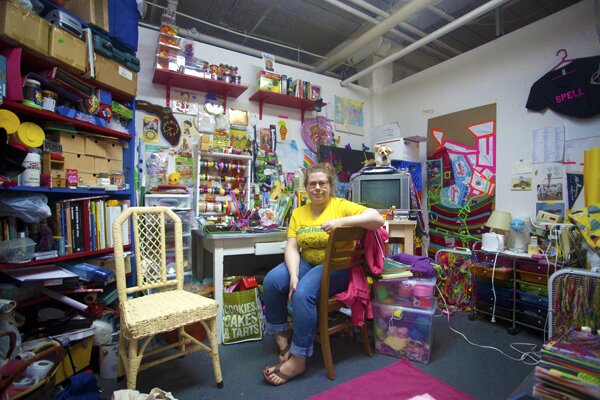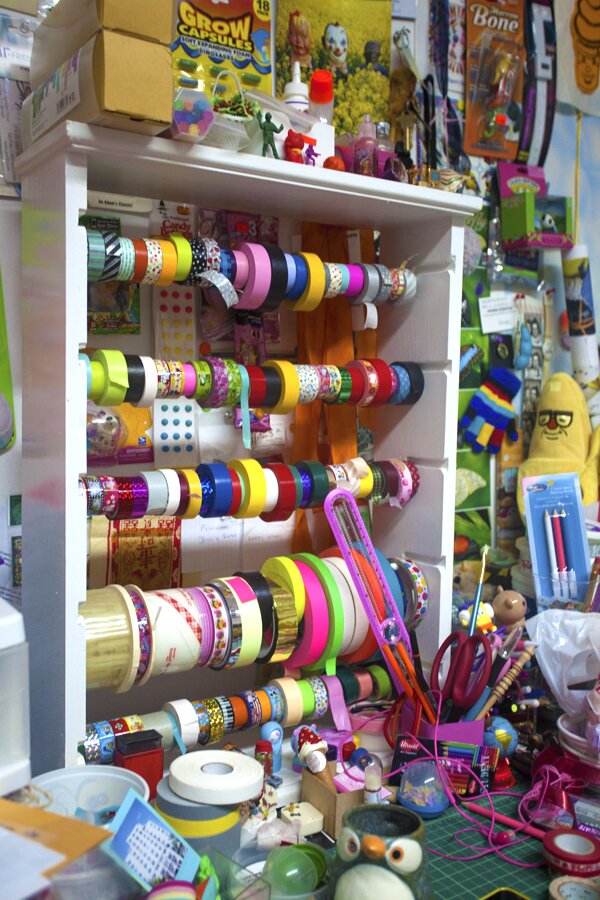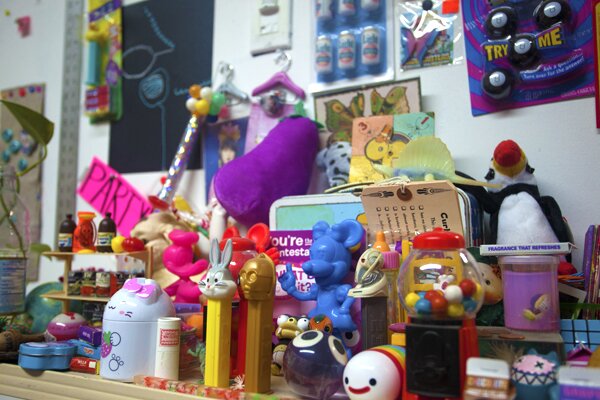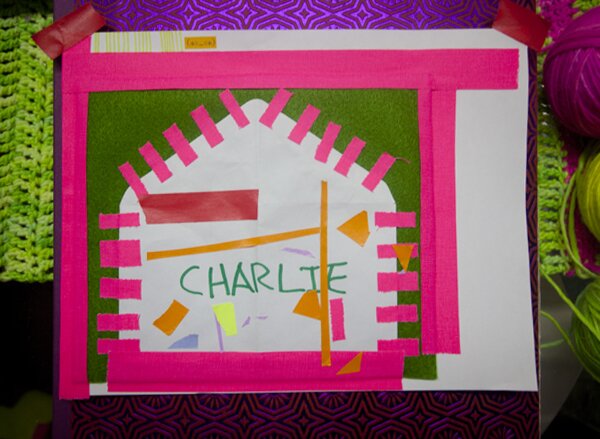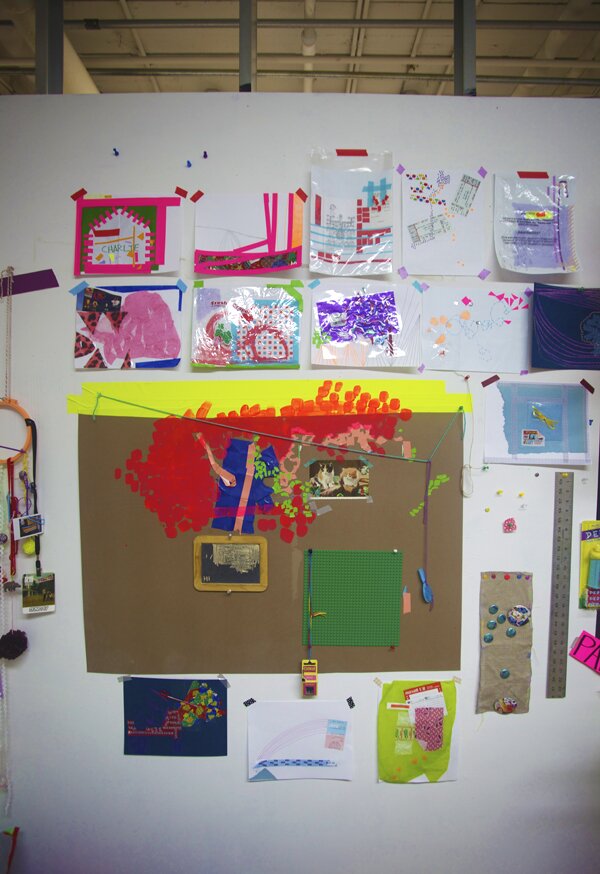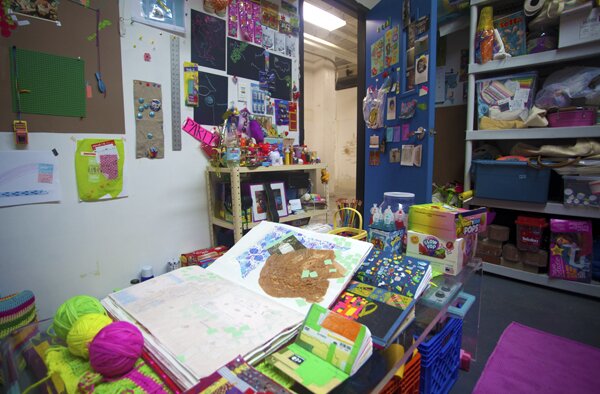is an installation artist currently residing in Brooklyn, New York. She recently graduated from the Pratt MFA program for Sculpture. In her last few days at school, Kelly showed us her studio while at Pratt and talked about her thesis work and her future plans.
F: Tell me about your most recent work.
KM: For my thesis show, I did an installation and a lot of the stuff that’s in here was part of it. I had half of the gallery and you had to take your shoes off to come into it. There were all these blankets and pillows and stuff on the floor and I had this table with all the artist books. I had these really big collages on the wall which are actually all rolled up in there right now because my studio is pretty small. I can’t have everything out all at once. Then I also had some smaller installations on the floor. I had two videos that were playing. They were stop motion animation videos. That was pretty much it. Oh, and I had a couple of these fans in there too and the lighting was kind of low – kind of like a bedroom. I had like four lamps…that were decorated and the overhead lights I had sort of dimmed. I sat in there the whole time. It was kind of like a performance. I received people and they could stay as long as they wanted. I had food and stuff out constantly and so, it was sort of about the conversations that I had with people when they were in the space and while they looked at everything. I sort of achieved everything I wanted to in one installation.
F: And you would acknowledge these viewers and talk to them about whatever you wanted to? What did you talk about?
KM: Yeah, I didn’t have a script or anything. I was basically being myself and inhabiting that space. People would sometimes talk about what they saw or ask questions about the work and they’d also ask questions about me and then we’d always start talking about random things, whatever they felt like talking about.
F: So, it’s almost in a weird sense, creating this comfort zone in a gallery setting and transforming it from a place that might not be the most comfortable.
KM: Yeah, I was thinking about two things- first of all, whenever you go to an opening, its kind of awkward like you don’t know what to do with yourself or your body. So I thought if I had a space where everyone could just sit on the floor, then people would want to stay longer and actually talk about stuff instead of just small talk. I was also thinking about myself and how for all the thesis shows here [at Pratt] are one person, one week shows and you have to be your own gallery guard. If I have to be in this space for a whole week by myself, who knows if people will come by. What kind of space would I want to be in?
F: In terms of the work because I see almost all of it as one single object. There are all these little objects that make up this one thing. Do you see it that way or do you see it as individual objects or finished pieces? How do you go about that in creating your work?
KM: I guess I think about them (like most things I make), they could be separate but they could also be part of something larger too. I think the book is a good metaphor for my work. You have this one object but within it, it contains multiple pages so you could tear them out or you could keep it all together.
F: You reference a lot of products that you find interesting and then, in turn, you’re creating products out of products. Is that a viewpoint of life in general? Can you talk about that?
KM: I’m definitely interested in consumerism and that was, maybe a few years ago, when that was a major conceptual component of my work. I think it’s sort of expanded out from that because it’s also about collecting and saving things and I’m also interested in the idea of souvenirs or objects containing memory or referencing the past.
F: I see a lot of these patch quilt things that become tapestries on the wall. That also in a way, becomes a metaphor.
KM: Yeah, everything is composed of little miniature things coming together. Also, the idea of being comforted by something. I’m also really interested in repetitive action too.
F: I would almost see that if you were to turn on that fan. It has that movement and the repetition that you were talking about in the fan. Back to the idea of the studio space… Being at Pratt, has that changed how you work in terms of your studio or being in different studio spaces. Do you do something over and over at each studio that you have?
KM: This is my second studio at Pratt. I had a smaller one my first year. I try, in all my studios, sort of divide materials that are waiting to be used and stuff that’s already being used. There’s half the space that I’m working in and the other half of the space is containing things to be worked with. I always recycle things in my work so if I build an installation then I can take it apart and use it again and sort of catalogue it. I always have things divided in different areas or bins by what they are. Usually above my desk area, where I make my books. I want to have lots of things to look at and those things I can use in a piece but then if they’re not being used, they come here for me to look at. I want to be able to see everything at once so that I can know what I have and be inspired to use it. I also like to watch TV while I work so I always have a TV and a DVD player and I’ll play a lot of TV shows.
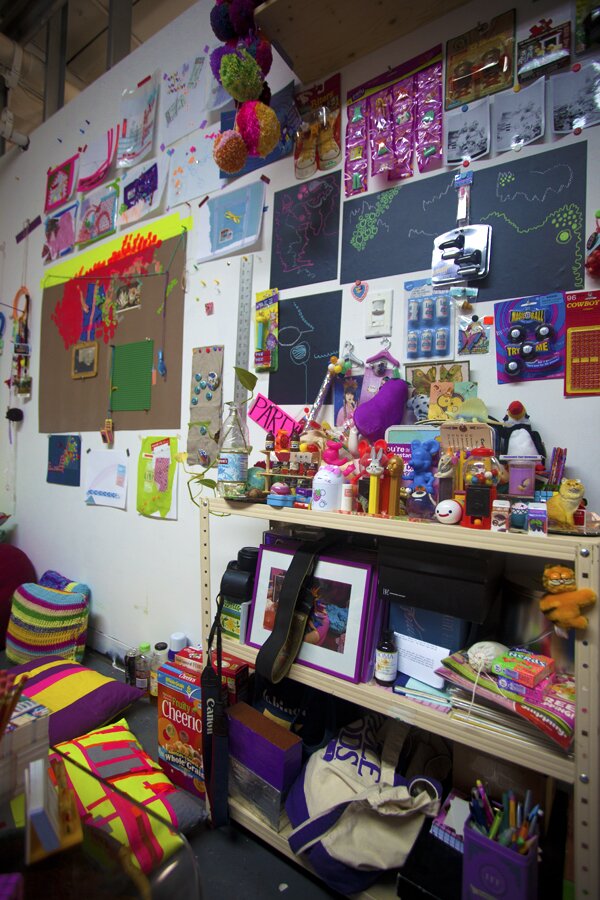
F: Do you think that even though you’re probably just listening and glancing over, that watching tv changes your work?
KM: Yeah, depending on what I’m watching, it changes what mood I’m in and how I make things. I usually try to watch things that I’ve already seen before so that I don’t have to pay attention to it but that I can still follow it.
F: In terms of the objects, how do you choose what you want. Is it more of what interests you or are there certain colors or aesthetic that you choose that reminds you of something? I almost see a childhood, like these would be the things that I would find under my bed 10 years later. Is there something where you used to have these toys and you’re trying to come back to it?
KM: Well, everything that I use in my work with the exception of maybe 2 or 3 things that I’ve ever used, is stuff that I’ve collected now as an adult. None of the things are directly from my childhood. A lot of times when I’m looking at something, it reminds me of something and that’s why I gravitate towards it. I want the things to be universal, like you said, something that anyone can gravitate towards. I am really drawn to things that you would forget about or are sort of unimportant in a way like packaging from things that you would throw away after you open it or stuff that you would get in the mail. I think there’s something about them where…I kind of think about what I do as making something out of nothing. All of the things are kind of forgettable in a way but when you bring attention to them, they change.
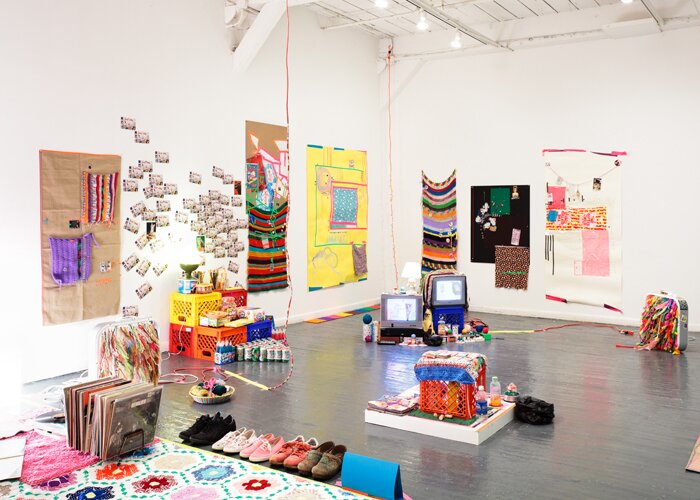
Image courtesy of Kelly McCafferty
F: I was reading an article and it was about this drugstore that they closed in 1992 but all this stuff stayed the same. They just boarded it all up and then they opened the store and its exactly the same. All these products from 1992, including magazines and that type of stuff were still there. There was this one thing that really caught my eye though. It was a box of bandaids in the tin metal box. It just reminds me exactly of what you’re talking about. These very specific things that are associated with certain memories.
KM: Yeah, I like what you’re saying about the store. I think about stores a lot having worked retail a lot in my life. Also, theres this five and dime store in Kentucky, where I grew up, that still exists. They keep the same products on the shelf and keep adding new things in. Every time I go in there, I’ll find this thing that’s from 20 years ago that’s still sitting on the shelf. I think that’s sort of how I think about my work because I use old things and new things. A lot of the new things that I use sort of make you think of old things so everything is sort of stuck in time somehow.
F: Do you consider what these objects would be like 20 years in the future?
KM: I haven’t thought about that before. I’ve been making my work in this way for about 5 years now. I used to make paintings before that. It’s been pretty consistent over those 5 years. I’ve been drawn to the same kinds of objects and using them in different ways and surprising myself. It’ll be really interesting to think about that. I think time in general is pretty important to me. A lot of things I think about are trying to hold on to time and stop it from going. I think that’s where a lot of the childhood ideas come from.

Image courtesy of Kelly McCafferty
F: Its interesting to see the drawings versus the collages. Do you see those as almost the same thing in a certain sense or different? I see the collages as paintings quite frankly. What’s your connection to the paintings you were making and the collages that you’re doing now?
KM: I started off making paintings. That’s always been what I’ve been drawn to. There’s a lot of things that I love about paint and paintings in general. When I was an undergrad, I first did paintings and they were oil paintings and then I did encaustic paintings. I got really sick from the process and inhaling the pigments. I became allergic to paint and solvents that I were using. I really had to change what I was doing. I couldn’t use the materials anymore. So, I started doing a lot of collages and drawings which I’ve always done. I love the idea of collage like finding something and finding a new home for it or reusing it and making it important again. I do feel that way too. I think about color and the relation of shape when I put things down. It could be painting in a way. Even when I’m doing an installation, I feel like its meant to be seen as a whole from above like one giant painting.
Update!
Kelly McCafferty will be in a two-person show alongside Panini Malekzadeh at . She will be showing an installation and a video/installation. The show will be up this summer from July 5-August 11, 2012.
You can find more of Kelly McCafferty’s work at

